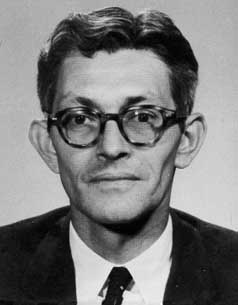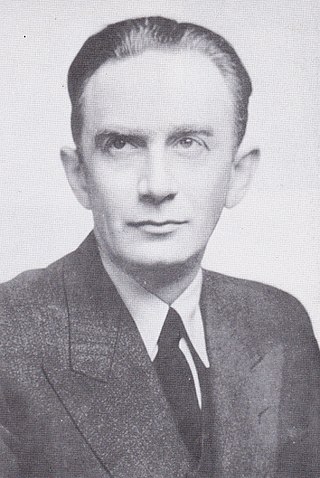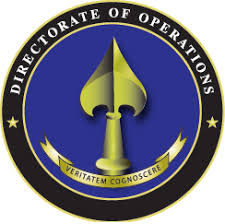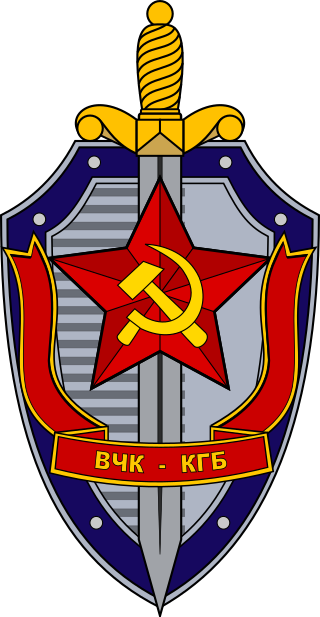Related Research Articles
CIA cryptonyms are code names or code words used by the U.S. Central Intelligence Agency (CIA) to refer to projects, operations, persons, agencies, etc.

Allen Welsh Dulles was the first civilian director of central intelligence (DCI), and its longest-serving director to-date. As head of the Central Intelligence Agency (CIA) during the early Cold War, he oversaw the 1953 Iranian coup d'état, the 1954 Guatemalan coup d'état, the Lockheed U-2 aircraft program, the Project MKUltra mind control program and the Bay of Pigs Invasion. He was fired by John F. Kennedy over the latter fiasco.

Counterintelligence (counter-intelligence) or counterespionage (counter-espionage) is any activity aimed at protecting an agency's intelligence program from an opposition's intelligence service. It includes gathering information and conducting activities to prevent espionage, sabotage, assassinations or other intelligence activities conducted by, for, or on behalf of foreign powers, organizations or persons.
A covert operation or undercover operation is a military or police operation involving a covert agent or troops acting under an assumed cover to conceal the identity of the party responsible. Some of the covert operations are also clandestine operations which are performed in secret and meant to stay secret, though many are not.

James Jesus Angleton was chief of counterintelligence for the Central Intelligence Agency (CIA) from 1954 to 1975. His official position within the organization was Associate Deputy Director of Operations for Counterintelligence (ADDOCI). Angleton was significantly involved in the US response to the purported KGB defectors Anatoliy Golitsyn and Yuri Nosenko. Angleton later became convinced the CIA harbored a high-ranking mole, and engaged in an intensive search. Whether this was a highly destructive witch hunt or appropriate caution vindicated by later moles remains a subject of intense historical debate.

Walter Germanovich Krivitsky was a Soviet intelligence officer who revealed plans of signing the Molotov–Ribbentrop Pact after he defected to the West.

The First Main Directorateof the Committee for State Security under the USSR council of ministers was the organization responsible for foreign operations and intelligence activities by providing for the training and management of covert agents, intelligence collection administration, and the acquisition of foreign and domestic political, scientific and technical intelligence for the Soviet Union. The First Chief Directorate was formed within the KGB directorate in 1954, and after the collapse of the Soviet Union became the Foreign Intelligence Service. The primary foreign intelligence service in Russia and the Soviet Union has been the GRU, a military intelligence organization and special operations force.
The MGB, an initialism for Ministerstvo gosudarstvennoy bezopasnosti SSSR, was the name of the Soviet state security apparatus dealing with internal and external security issues: secret police duties, foreign and domestic intelligence and counterintelligence, etc. from 1946 to 1953.
Subversion refers to a process by which the values and principles of a system in place are contradicted or reversed in an attempt to transform the established social order and its structures of power, authority, tradition, hierarchy, and social norms. Subversion can be described as an attack on the public morale and, "the will to resist intervention are the products of combined political and social or class loyalties which are usually attached to national symbols. Following penetration, and parallel with the forced disintegration of political and social institutions of the state, these tendencies may be detached and transferred to the political or ideological cause of the aggressor".

The Directorate of Operations (DO), less formally called the Clandestine Service, is a component of the US Central Intelligence Agency. It was known as the Directorate of Plans from 1951 to 1973; as the Directorate of Operations from 1973 to 2005; and as the National Clandestine Service (NCS) from 2005 to 2015.
U.S. Army Field Manual 30-31B is a document claiming to be a classified appendix to a U.S. Army Field Manual that describes top secret counterinsurgency tactics. In particular, it identifies a "strategy of tension" involving violent attacks which are then blamed on radical left-wing groups in order to convince allied governments of the need for counter-action. It has been called the Westmoreland Field Manual because it is signed with the alleged signature of General William Westmoreland. It was labelled as supplement B, although the publicly released version of FM30-31 only has one appendix, Supplement A.
Countries with major counterintelligence failures are presented alphabetically. In each case, there is at least one systemic problem with seeking penetration agents when few or none may actually have existed, to the detriment of the functioning of the national service involved.
National governments deal in both intelligence and military special operations functions that either should be completely secret, or simply cannot be linked to the sponsor. It is a continuing and unsolved question for governments whether clandestine intelligence collection and covert action should be under the same agency. The arguments for doing so include having centralized functions for monitoring covert action and clandestine HUMINT and making sure they do not conflict, as well as avoiding duplication in common services such as cover identity support, counterespionage, and secret communications. The arguments against doing so suggest that the management of the two activities takes a quite different mindset and skills, in part because clandestine collection almost always is on a slower timeline than covert action.
With Europe stabilizing along the Iron Curtain, the CIA attempted to limit the spread of Soviet influence elsewhere around the world. Much of the basic model came from George Kennan's "containment" strategy from 1947, a foundation of US policy for decades.

Counterintelligence state is a state where the state security service penetrates and permeates all societal institutions, including the military. The term has been applied by historians and political commentators to the former Soviet Union, the former German Democratic Republic, Cuba after the 1959 revolution, Iraq under Saddam Hussein, China under the Chinese Communist Party, and post-Soviet Russia under Vladimir Putin, especially since 2012.

The Committee for State Security was the main security agency for the Soviet Union from 13 March 1954 until 3 December 1991. As a direct successor of preceding agencies such as the Cheka, GPU, OGPU, NKGB, NKVD and MGB, it was attached to the Council of Ministers. It was the chief government agency of "union-republican jurisdiction", carrying out internal security, foreign intelligence, counter-intelligence and secret police functions. Similar agencies operated in each of the republics of the Soviet Union aside from the Russian SFSR, where the KGB was headquartered, with many associated ministries, state committees and state commissions.
The Report on the Covert Activities of the Central Intelligence Agency is a 69-page formerly classified comprehensive study on the personnel, security, adequacy, and efficacy of the Central Intelligence Agency written by Lieutenant General James H. Doolittle. United States President Dwight Eisenhower requested the report in July 1954 at the height of the Cold War and following coups in Iran and Guatemala. The report compares with other contemporary Cold War documents such as George Kennan's "X" article in Foreign Affairs, which recommended a policy of "containment" rather than direct confrontation with the Soviet Union, and NSC 68, the secret policy document produced in 1950, which recommended a similarly restrained policy of “gradual coercion.” Doolittle wrote with an abandon-all-principles approach that conveyed the national fear that the United States faced the prospect of annihilation at the hands of the Soviet Union: “It is now clear that we are facing an implacable enemy whose avowed objective is world domination by whatever means and at whatever cost,” Doolittle wrote. “There are no rules in such a game… If the United States is to survive, long standing concepts of ‘fair play’ must be reconsidered.” Doolittle’s forceful policy and language reflected the fear that motivated American citizens and policymakers in the wake of Soviet Communism.

Rufus Lackland Taylor Jr. was an officer in the United States Navy. Eventually he became Director of the Office of Naval Intelligence and held the rank of Vice Admiral. In 1966 he was appointed as Deputy Director of the Defense Intelligence Agency (DIA), then shortly thereafter as Deputy Director of the CIA, where he served from 1966 to 1969.

Political warfare is the use of political means to compel an opponent to do one's will, based on hostile intent. The term political describes the calculated interaction between a government and a target audience, including another state's government, military, and/or general population. Governments use a variety of techniques to coerce certain actions, thereby gaining relative advantage over an opponent. The techniques include propaganda and psychological operations ("PsyOps"), which service national and military objectives respectively. Propaganda has many aspects and a hostile and coercive political purpose. Psychological operations are for strategic and tactical military objectives and may be intended for hostile military and civilian populations.

Roy Godson is an academic and scholar within the fields of international politics and national security, and a professor emeritus at Georgetown University.
References
- 1 2 3 "Paul W. Blackstock". Carnegie Council for Ethics in International Affairs. 1970. Retrieved 7 April 2023.
- 1 2 "Professor Paul W. Blackstock to Lecture at the University of Dayton". University of Dayton. 29 January 1973. Retrieved 7 April 2023.
- 1 2 Jack Raymond (17 January 1965). "Undercover Operations". New York Times. p. 117. Retrieved 7 April 2023.
- ↑ (anonymous). "Book review of The Secret Road to World War Two: Soviet Versus Western Intelligence, 1921-1939 by Paul W. Blackstock" (PDF). Studies in Intelligence. Central Intelligence Agency. Retrieved 7 April 2023.
- ↑ Paul W. Blackstock (1966). Agents of Deceit. Quadrangle. Retrieved 7 April 2023.
- ↑ Paul W. Blackstock (1969). Secret Road to World War Two: Soviet versus Western Intelligence, 1921-1939. Quadrangle. Retrieved 7 April 2023.
- ↑ William J. Barnds; Paul W. Blackstock; Wilson Carey McWilliams; Daniel C. Maguire (1969). The Right to Know, to Withhold & to Lie. Council on Religion and International Affairs. Retrieved 7 April 2023.
- ↑ Paul W. Blackstock; Frank L. Schaf Jr. (1978). Intelligence, Espionage, Counterespionage, and Covert Operations: A Guide to Information Sources. Gale Research. Retrieved 7 April 2023.
- ↑ Paul W. Blackstock; Bert F. Hoselitz (1953). The Russian Menace to Europe: a collection of articles, speeches letters, and news despatches [by] Karl Marx and Friedrich Engels. Allen and Unwin. Retrieved 7 April 2023.
- ↑ Alexander I Solzhenitsyn (1963). "translation by Paul W. Blackstock". "We never make mistakes"; two short novels, by Alexander Solzhenitsyn. University of South Carolina Press. Retrieved 7 April 2023.
- ↑ Paul W. Blackstock (1966). "'Books for Idiots': False Soviet 'Memoirs'". The Russian Review: 285–296. Retrieved 7 April 2023.
- ↑ Paul W. Blackstock (April 1969). "The Tukhachevsky Affair". The Russian Review: 171–190.
- ↑ Paul W. Blackstock (1 May 1970). "On the Moral Implications of Torture and Exemplary Assassination". Carnegie Council for Ethics in International Affairs. Retrieved 7 April 2023.